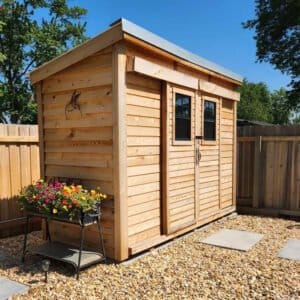No products in the cart.
May 3, 2016
 Flowers in your garden ensure color especially in the summer and the fall. However, a marvelous flower garden does not develop by just ordering flowering plants and planting them wherever there is space.
Flowers in your garden ensure color especially in the summer and the fall. However, a marvelous flower garden does not develop by just ordering flowering plants and planting them wherever there is space.Overall Considerations when Planning a Flower Garden
You need to begin with a plan that should include large deciduous trees, evergreen hedges, perennial flowering shrubs, and finally seasonal plants that add color. Following this scheme when planning a flower garden will ensure that your garden has structure as well as color.Plant the Trees First
If you are starting a garden from scratch, plant the trees first. The deciduous trees will grow to be large and cast a shade over a large section of your garden, so locate them with care. The trees should be located at spots where you would like to place a bench or similar seating and away from where you want a lawn or flower bed that will require plenty of sunlight.Hedges
Once the trees have been planted, decide on the location of hedges to create paths and alleys. These should be planted next.Perennials
After you have planted the hedges, decide where you want to locate the perennial flowering plants. These will grow to be tall and need sunlight as well.Flower Beds
After all of these have been located, make flower beds that can border the lawn or line the paths. Plant these with flowers that will add color to the garden.By planting a mix of flowering plants that bloom in the summer as well as those that bloom in the fall, you will be able to have a colorful garden for a longer period of time.Different Flower Garden Styles
While the basics of a flower garden design are the same, each garden should be unique and reflect your particular style. Before you begin planting the trees and the hedges, consider what sort of flower garden appeals to you.A flower garden can have curved paths and a profusion of blooms in an informal array, straight alleys and more formal design, easy to grow flowers or a group of exotic orchids or cacti.Additionally, you need to keep in mind the flowers that will grow best in the climate conditions of your locality.Width of Flower Beds
When planning your flower beds aim for a broader bed that will accommodate multiple layers of flowers. A minimum of five feet width is needed to ensure that the flower bed has at least three layers of flowers, giving it a colorful and lush appearance.If your garden is larger, you can even make the flower bed 10 feet wide and plant multiple layers of flowers of varying heights and colors.Borders vs Islands
Again, the decision to have flower bed borders or a flower island depends on both your tastes and the space available. Plant flower borders along hedges and close to the fence or wall of the house. If you have a large lawn, you can also include an island flower bed.While border flower beds have the large plants away from the path and toward the house or hedge, island flower beds should have the taller plants at the center and gradually taper off to the shortest plants.Sunshine, Climate, and Soil Types
When planning a flower garden and choosing the plants for it, you need to take into account the amount of sunshine the garden receives, the climate, and the soil type. Of these the soil type is the easiest to fix. Just get the soil tested and add fertilizer, manure, and compost to the soil to improve its health and ability to sustain various flowering plants.However, your choice of flowering plants should also take into account the sunlight the garden receives and the climate of the locality. Consult with the local horticultural organization to find out which flowering plants grow best in your area and select your plants from them.This is especially a marvelous idea for new gardeners, as local plants are more likely to thrive even under an inexperienced gardener. Some plants require shade, so these can be planted in areas of the garden that receive less sunlight, ensuring that most of the garden has colorful plants that will add vibrancy to the outdoors.Leave Space for Growing
When planning a flower garden, keep in mind the final size of the plants. This will help you space out the flowering plants at an adequate distance so that they do not crowd each other or leave the flower beds looking sparse.Each plant has its own space needs and you need to learn about them before you begin planting the seeds, seedlings, or cuttings.Creepers
Apart from flower beds, a garden can also have creepers and climbers that flower. Planting a climber that flowers in the fall close to the trellis will provide a colorful and shady arbor for the summer and the fall.May 3, 2016
-
 On SaleSale!%Off8Save $195195$8%195$On SaleSale!%Off6Save $150150$6%150$On SaleSale!%Off8Save $195195$8%195$
On SaleSale!%Off8Save $195195$8%195$On SaleSale!%Off6Save $150150$6%150$On SaleSale!%Off8Save $195195$8%195$ -
 On SaleSale!%Off11Save $230230$11%230$On SaleSale!%Off11Save $230230$11%230$
On SaleSale!%Off11Save $230230$11%230$On SaleSale!%Off11Save $230230$11%230$ -
 On SaleSale!%Off13Save $930930$13%930$On SaleSale!%Off7Save $445445$7%445$On SaleSale!%Off7Save $400400$7%400$On SaleSale!%Off13Save $930930$13%930$
On SaleSale!%Off13Save $930930$13%930$On SaleSale!%Off7Save $445445$7%445$On SaleSale!%Off7Save $400400$7%400$On SaleSale!%Off13Save $930930$13%930$New
-
 On SaleSale!%Off11Save $1,1541154$11%1154$On SaleSale!%Off10Save $906906$10%906$On SaleSale!%Off10Save $861861$10%861$On SaleSale!%Off11Save $1,1541154$11%1154$
On SaleSale!%Off11Save $1,1541154$11%1154$On SaleSale!%Off10Save $906906$10%906$On SaleSale!%Off10Save $861861$10%861$On SaleSale!%Off11Save $1,1541154$11%1154$ -
 On SaleSale!%Off7Save $339339$7%339$On SaleSale!%Off6Save $260260$6%260$On SaleSale!%Off11Save $485485$11%485$On SaleSale!%Off11Save $485485$11%485$
On SaleSale!%Off7Save $339339$7%339$On SaleSale!%Off6Save $260260$6%260$On SaleSale!%Off11Save $485485$11%485$On SaleSale!%Off11Save $485485$11%485$ -
 On SaleSale!%Off8Save $155155$8%155$On SaleSale!%Off10Save $190190$10%190$On SaleSale!%Off10Save $190190$10%190$
On SaleSale!%Off8Save $155155$8%155$On SaleSale!%Off10Save $190190$10%190$On SaleSale!%Off10Save $190190$10%190$










